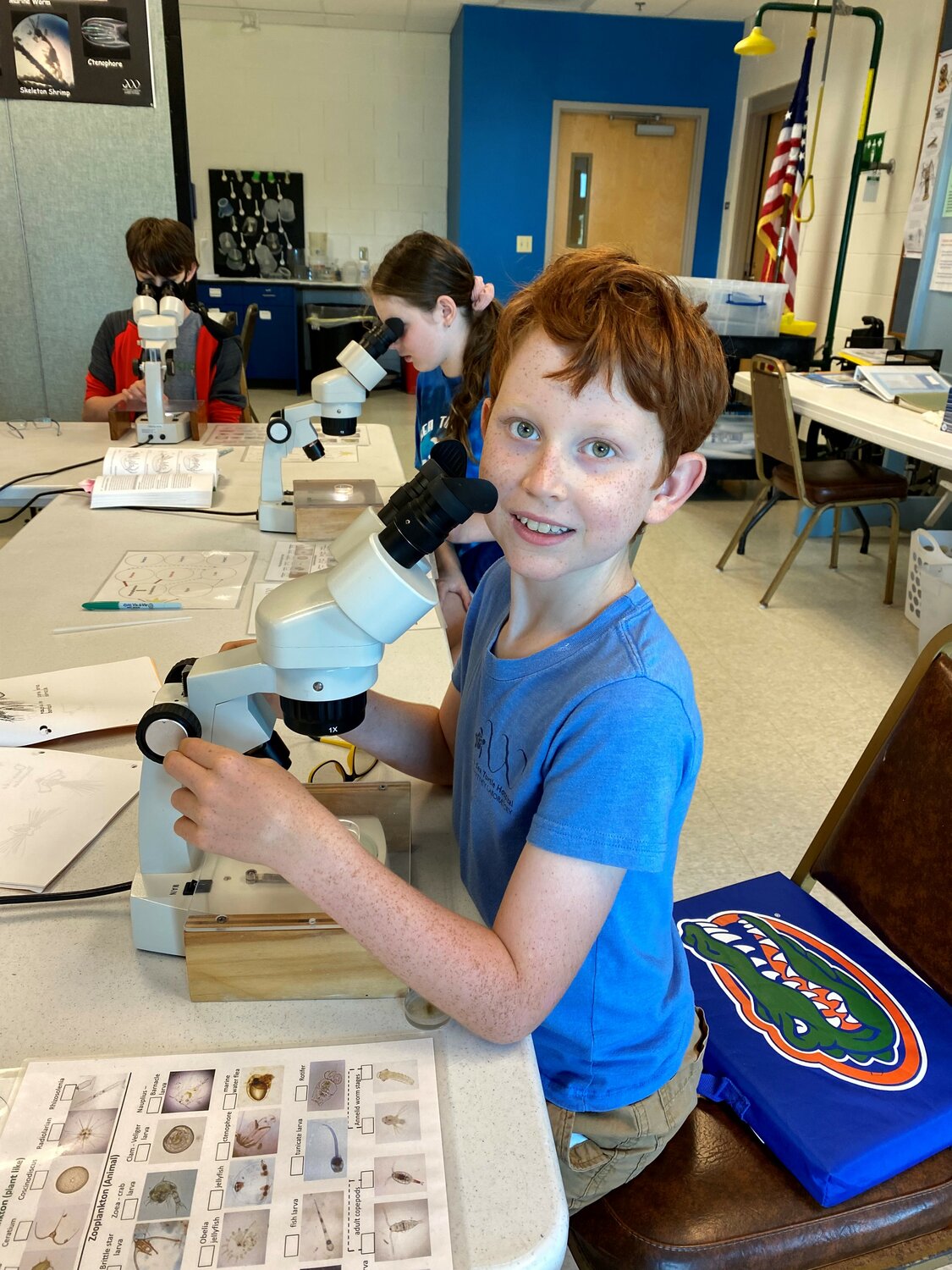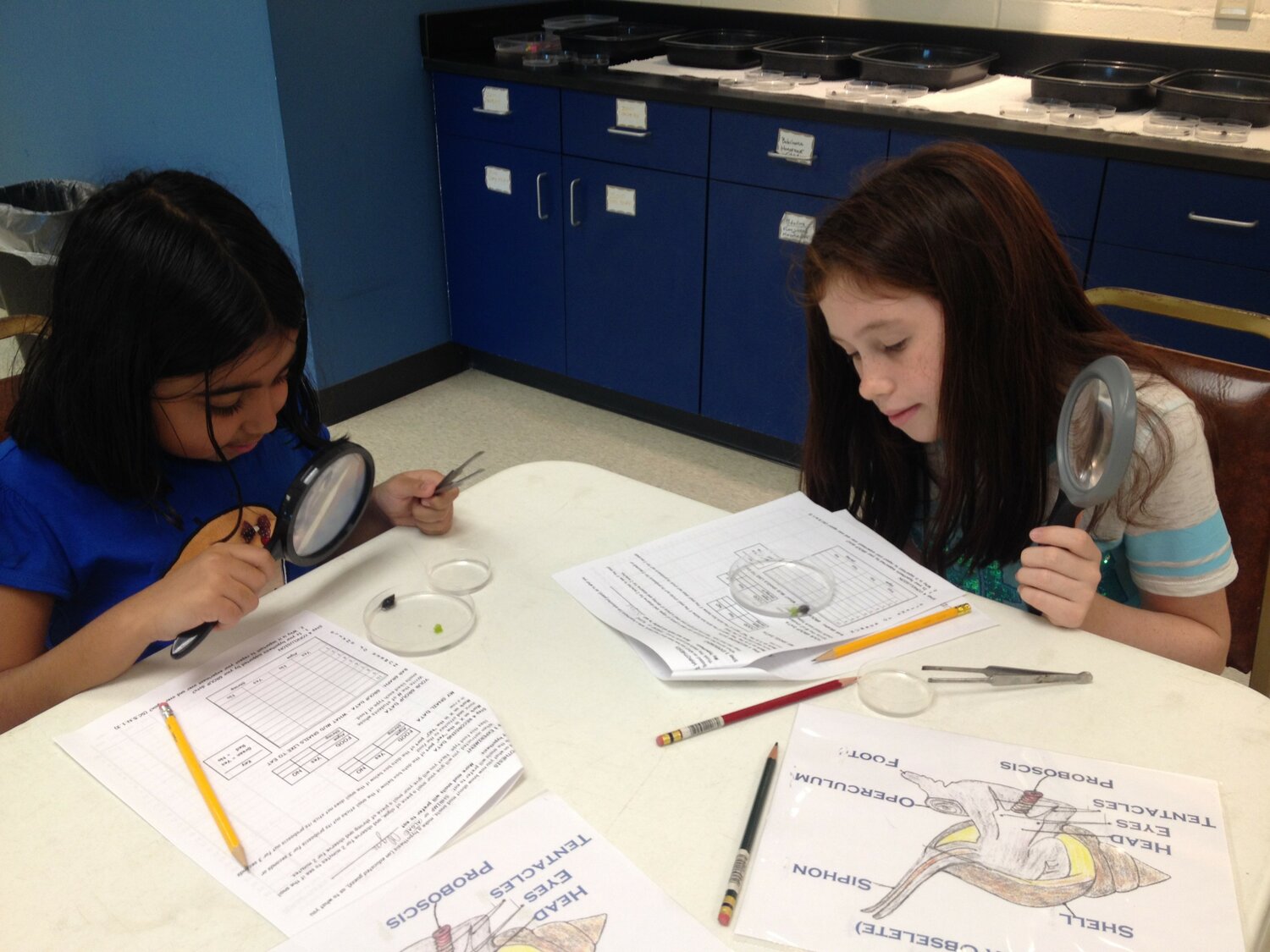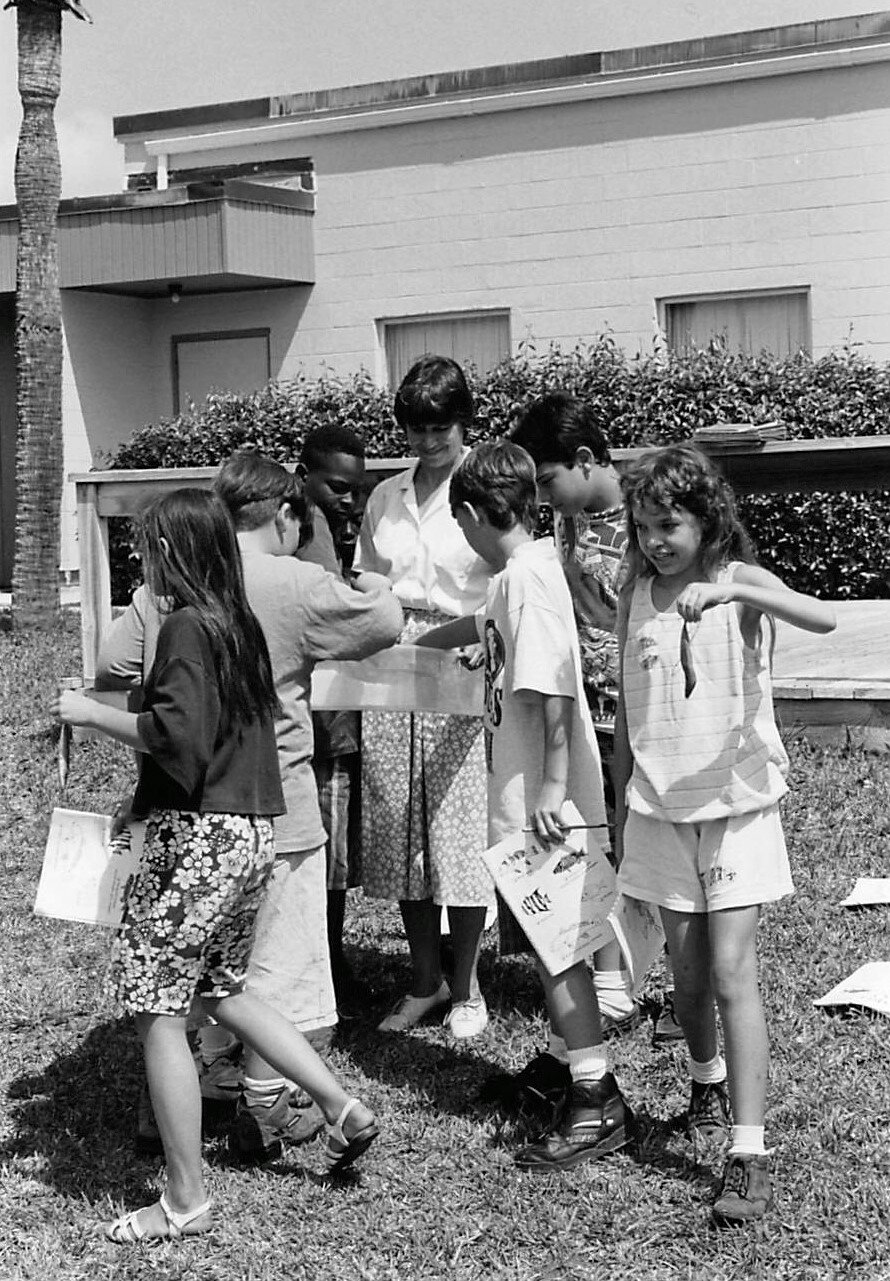Day at the Whitney Lab celebrates 30 years
Program introduces students to life as a scientist
Eight children sit arranged so they can see the education volunteer at the front of the room. They’re each hunched over and looking through a microscope while the volunteer walks around helping with the magnification and focus knobs. She asks the children scientists what they are seeing, and they note the differences between bryozoans and hydroids, checking off their observations on a laminated sheet. After they’ve had a chance to see a variety of tiny critters, the volunteer tells them they have some free time to look at any of the dishes beside their microscope, and it's like the bell has gone off for recess. At one point, a student calls his friend over and points to the dish under the lens, asking, “Can I show you what I’m seeing?” They huddle together at the same microscope, sharing a moment to “ooh” and “ahh” together.
These students are just a sampling of the thousands who have participated in the Day at the Whitney Lab over the last 30 years. This program, created by faculty and volunteers at University of Florida’s Whitney Laboratory for Marine Bioscience, is designed to help children experience what it’s like being a scientist. And, after the difficulties of the global pandemic that forced the lab to close for a time, its school programs are rolling once more.
“This all started from a couple of moms who recognized a need and decided to do something about it,” said Barbara Battelle, a retired UF professor emerita who specialized in the biochemistry of vision. Between running a lab, conducting experiments and writing grant proposals, Battelle also volunteered at her daughter’s elementary school. During these experiences, she noticed students struggling with science and teachers who needed additional support. Many of these teachers would ask Battelle if Whitney Laboratory had any programs for elementary school students.
“I got tired of saying no and finally said yes,” Battelle admitted. “Sometimes you have to say yes and just figure it out.”
The challenge was getting the program started. At the time, communities near Whitney didn’t know about the lab.
Funding was another hurdle. Whitney Lab was too small to garner any attention from NSF, a federal funding source for scientific research, to provide money for community outreach programs. That meant that any activities would have to be paid out of pocket.
Battelle received permission from then-director Michael Greenberg to create and run the first Day at the Whitney Lab program in 1993.
“At least he didn’t say not to do it,” Battelle said with a laugh.
The first “committee” consisted of three individuals: Battelle, the professional scientist; Christine Skipp, a cardiac-nurse-turned-elementary-school-teacher; and Mrs. Skipp’s husband, who happened to be a graphic artist. Together, the three of them pieced together the first work booklet for visiting children. Fifteen community volunteers joined the skeleton crew.
“If we could find a warm body who wanted to help, we figured out how to use them,” Battelle said.
One of the first experiments in the early years of the program was designed by a fifth-grade student as his science fair project. Children observed parasitic flatworms clinging to the underbellies of horseshoe crabs. These worms were removed and placed in a container with a Y-shaped tube connected to a clean bowl and a bowl where horseshoe crabs had been stored. Students hypothesized where they thought the worm would go and then observed. Afterwards, students discussed why they thought the worms chose a specific path given the fact that these parasites didn’t have noses or real eyes. How did they know where to go?
Over the years, the experiments may have changed, but the goal has remained the same.
“We tried to turn everything on its head,” Battelle said, explaining how science is sometimes approached with a didactic lens that limits perspective and wonder. “Our goal was to get kids to observe natural phenomena and ask questions.”
This can sometimes be overlooked in the effort to teach mandated curricula and prepare students for standardized tests. But research shows that most Nobel Prize winners developed an interest in science at a young age and outside of standard classroom activities. Whitney Laboratory is taking that message to heart with its hands-on, question-and-observation-based approach to inspire scientific curiosity beyond the confines of a textbook.
“Does every kid who comes through become a scientist?” Battelle asked. “99.9% of the time, probably not. But those kids can now associate science with something cool.”
Within five years, the Day at the Whitney Lab expanded to include a Traveling Zoo where Whitney staff and volunteers would drive to local schools and visit the classrooms. By this point, there was enough community interest to warrant a full-time education coordinator at the Whitney Lab. Brenda Cannaliato, the lab’s current education program manager, was hired in 2007. Over the first 28 years of Whitney Lab’s school programs, the pool of community volunteers would grow to more than 90 individuals, each valued at approximately $29 per hour. In that time, Whitney’s education programs would serve seven counties and inspire more than 80,000 local students.
“We never want to duplicate anything the teacher can do in the classroom,” Cannaliato explained, emphasizing that the purpose of these programs is to enhance curricula and justify the cost of a visiting class.
In 2020, COVID-19 disrupted Whitney Laboratory and local school operations. The lab was forced to work with minimal staff, and the number of available volunteers shrank to just six individuals. Local schools closed their doors and moved their classes to online Zoom formats.
“During shutdowns, we didn’t want teachers to go without,” Cannaliato explained. “We didn’t have an online presence and had to adjust on the fly with the teachers. We still wanted to provide that service.”
Cannaliato and Amy Biedenbach, the education program coordinator at Whitney Laboratory, developed a hybrid experience to replicate one of the experiments children conduct when visiting the lab. Called “Snails on the Move,” this hybrid format consists of a kit complete with forceps, magnifying glasses, even live mud snails — everything a teacher would need to distribute to children. A Whitney supporter purchased filming equipment while Pete Meyers, a board member specializing in online visual design, helped compile web curricula and videos of Biedenbach doing the experiment. Teachers could click the link and share the material with students as Biedenbach guided the class through the lesson plan. Meyers and his team at EP Visual Design also helped the lab develop a virtual microscope experience for students to use.
During this time, some schools wouldn’t allow any visitors into the building. Whitney staff and volunteers would coordinate with teachers and load the Traveling Zoo van with the materials for “Snails on the Move.” After arriving at the school, masked teachers and staff members would exchange the goods in the empty parking lot.
Two other Whitney programs were created to address the needs of virtual or socially distant interactions during the pandemic. These include home learner activities geared toward individual students who could visit the lab and have a more personalized, one-on-one experience. Biedenbach also expanded summer day camps to include sixth and seventh graders in addition to elementary-school students.
Whitney Laboratory has also grown its online presence. Last year, faculty, staff and graduate students from the Whitney science community shared their Paths to Science videos describing examples of the many different paths that lead to science careers. These videos are posted on Whitney’s webpage.
Cannaliato is also in the process of creating Whitney Laboratory’s very first turtle education program for high school students interested in veterinary or health academies or marine biology. This program, inspired by Dr. Jessica Farrell’s recent dissertation defense at Whitney, will consist of an online curriculum covering advanced topics in science.
Now, as the community and the lab are recovering from the pandemic, things are starting to return to normal. And, according to Cannaliato, these new programs are here to stay.
“Once we create something, we don’t want it to go away, especially if it works,” she said. With these new programs, Whitney expects to serve an additional 700 students each year, plus thousands more online through YouTube and career path videos.
“We can grow anything if you give us the space, the staff and the time,” Cannaliato said.
Whitney’s new programs responding to the needs of classrooms highlight a niche that the lab is willing to fill, with potential to expand even more. Despite these additions and efforts to minimize costs — especially for underserved schools — Whitney still does not receive federal support or community funding beyond private donations to serve more than 5,000 students each year. More support is needed to deliver these programs and continue inspiring kids to get excited about science. Whitney Laboratory started an endowment fund with a foundation matching support to help sustain the K-12 program and continues to seek donations that can be matched one to one to sustain the program for youth.
The hybrid class experience, “Snails on the Move,” was underwritten the first year for all schools and now remains free of charge to Title I schools where more than 50% of students receive free or reduced lunches. This service to underserved schools is funded by a private foundation who also provided Whitney’s mobile marine zoo van.
As of this summer, Whitney’s programs are already filling up for next school year. And the promise of the Whitney staff and its 40-plus volunteers is that the experience will be memorable.
One of the activities of the Day at the Whitney Lab allows students to develop a hypothesis and test it. Each child is given a petri dish with a live mud snail zipping around, and in the first several minutes the young scientists point to the waving siphons and the tentacles feeling around. At the front of the room, a volunteer displays the snail’s anatomy with the aid of a home-crocheted mud snail, popping out the proboscis to show how the snail eats.
Another volunteer passes around Q-tips dipped in snail chow with the instruction: “Just watch.” There are several squeals of excitement, and the children say, “I see it! I see it!” as the proboscis of their snail wriggles out to lick the Q-tip. Someone asks a question, and the volunteer responds, “You guys are the scientists today. What do you think?”












